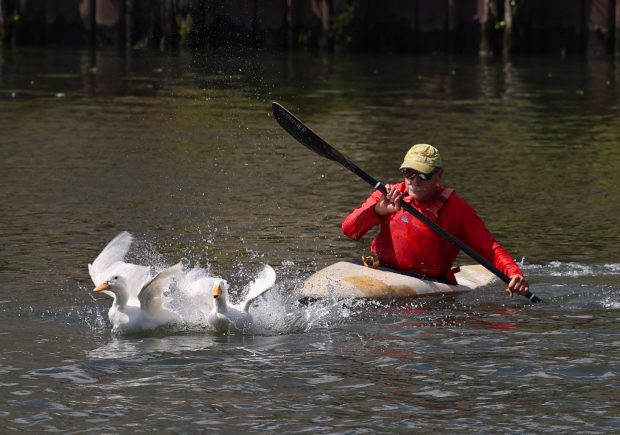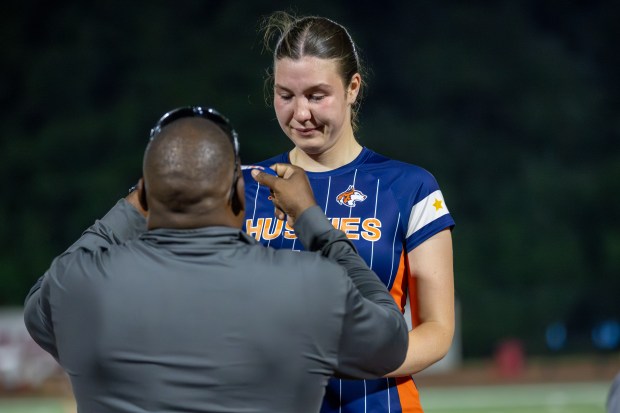The bright white feathers of a pair of Pekin ducks ruffled in the summer breeze as they snoozed on concrete steps leading into the Chicago River at Ping Tom Memorial Park. The birds were unfazed by the whistling trains, the rumbling traffic of the city and the nearby gaggles of Canada geese and wild mallards.
As former pets, humans didn’t disturb them either. That is until a woman from a bird rescue group tried to net them.
When the ducks quickly dispersed, she took out a walkie-talkie and called for reinforcements. In moments, a volunteer whizzed by in a kayak, ready to catch the waterfowl with his bare hands as he expertly maneuvered the vessel.
Chicago Bird Collision Monitors rescues thousands of birds annually, said the organization’s director, Annette Prince. Over a hundred of those rescue calls involve former pet ducks such as the Pekins, who had been at the park in Chinatown for a few months.
They are left to fend for themselves — but experts say it’s often a death sentence. There’s no official data on how often this happens, but according to an estimate by an anthrozoologist in a 2023 National Geographic report, tens of thousands of domestic ducks are dumped each year throughout the United States.
“This is a true education problem,” said Adrienne Eyer, a volunteer with the bird monitors project.
Domestic ducks in the wild become easy targets for predators; they are literally sitting ducks. Being bred and reared for the meat industry means most domestic ducks can’t fly because their bodies are oversized and their wings are too small. And Chicago has no shortage of possible predators, including coyotes, foxes, raccoons, hawks and great horned owls. As pets, ducks also learn to depend on humans for food so they aren’t prepared to forage.
Every spring, families purchase chicks, rabbits and ducklings from local feed sellers and pet stores to include the cute animals in their Easter baskets and seasonal pictures.
After a few months, the novelty often wears off. As temperatures drop, owners realize they can’t keep a growing duck in their backyard or inside their home — and some mistakenly believe the winged animal will be able to survive in the wild. Instead, they are effectively putting it in harm’s way, which is also illegal.
“They are not expendable party favors, they’re living things you should only plan on getting if you’re planning on being a responsible owner,” Prince said.
‘Needlessly abandoned’
The bird collision volunteer network tries to respond to all calls in the Chicago area about domestic ducks, but Prince said the efforts divert precious energy from saving birds injured on the country’s largest migratory route — the Mississippi Flyway — to birds “needlessly abandoned.” Other domestic breeds frequently dumped in ponds and nature areas around Chicago include Swedish Blue and Indian Runner ducks.
She said pet ducks, like any other pets, represent a commitment for as long as they live, which can be eight to more than 10 years in captivity. But their life expectancy can be easily halved in the wild, and experts say ducks likely experience traumatizing emotions from abandonment.
During a Humboldt Park rescue, Eyer said she was approached by a family who told her they had watched a crying and clearly distraught woman dump a pair of ducks earlier that day.
“Domestic ducks are kind of like dogs or cats,” she told the Tribune. “They’re very people-oriented, they have big personalities, they very endearing and very charming.”
Duck dumping is illegal in Illinois under the section for cruel treatment in the state’s Humane Care for Animals Act: “No owner may abandon any animal where it may become a public charge or may suffer injury, hunger or exposure.”
Violating this state law is a criminal offense considered a Class A misdemeanor — the most severe of its kind, which also includes theft, criminal trespass, battery and aggravated assault. Such offenses can be punished by up to a year in jail, a fine of up to $2,500 and mandatory court assessments.
Chris Anchor, a senior wildlife biologist at the Forest Preserves of Cook County, said visitors dump all kinds of pets in their natural areas, including ducks but also cats, dogs, parakeets, exotic snakes and gerbils. But as the county’s 22 nature preserves span tens of thousands of acres, rarely does the staff get to the abandoned pets in time to give them a second chance.“Many times, we find out when we find an animal that has died,” Anchor said.
Sometimes, a singular pile of feathers will be how staff discovers a duck was left behind and became prey.
The vast majority of pet owners doing the dumping, he said, likely do so because they had no idea what they were getting into in the first place and then it became too much of a burden or too messy to keep the animal.
Besides violating state law, abandoning animals in the forest preserves of Cook County is punishable per the district code by a fine of $75 to $500.
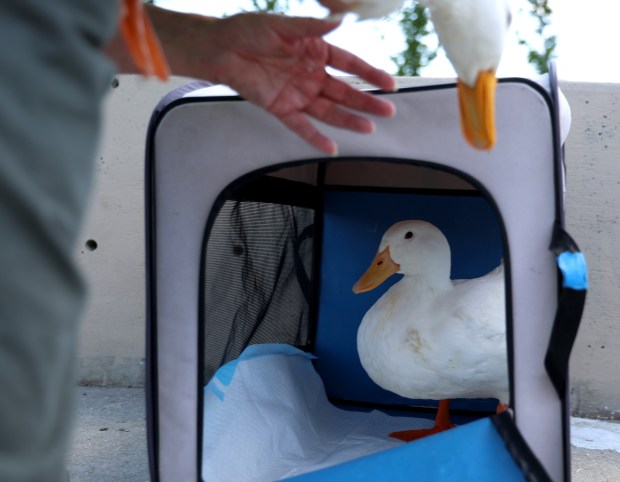
The Chicago Park District, which owns some of the city parks where volunteers like Prince and Eyer have rescued ducks, said in an emailed statement that it discourages the “disposal of unwanted pets” for public safety reasons and the health of the animals and habitats.
“Our park-based ponds are teeming with wildlife. However, we are unaware of any pet ducks being left behind at ponds,” the statement said. “Unknown disposal of pets in our parks and facilities is a very rare occurrence.”
The Park District also warned the public not to engage wildlife without proper permission and precautions and suggested that people contact Chicago Animal Care and Control at 311, to report an injured or domestic duck.
An education problem
Advocates and experts say education should start from the beginning of the supply chain.
“You can have your Instagram moment, your big, grand gesture, your perfect little Easter, without affecting the welfare of these animals,” Eyer said.
Ducks can be purchased from feed stores for $5 to $20 each but generally must be bought at least two at a time because they require company. Little information is passed on to potential owners about their responsibilities. On the other hand, the process of getting a dog or cat can be expensive, and adopting one can also require a background check.
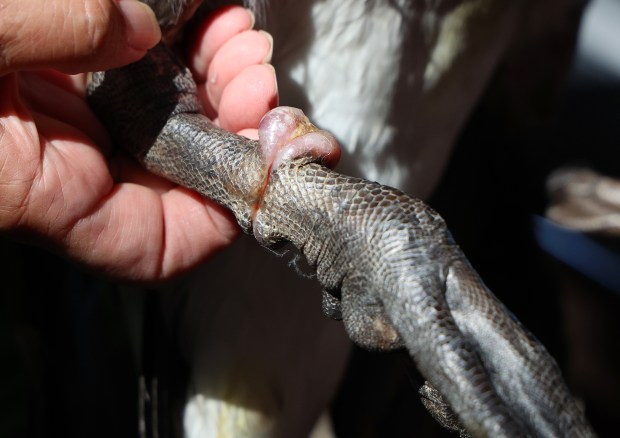
Ten years ago, Grayslake resident Kerri Gburek started taking stray chickens and ducks home from her job as a veterinary technician. Her passion has grown into a small business — the “Chicken Eggspert” — educating potential owners with home consultations and classes at the Lake County Farm Bureau, offering expertise in village board meetings in municipalities passing poultry ordinances, and renting out chicks and ducks around the Easter holiday so families can take photos and interact with the birds without having to commit. She also offers day or weeklong hatching projects for school classrooms and families at home.
“I try to offer a solution so that those folks who maybe aren’t as educated about the husbandry requirements aren’t going out and purchasing them,” she said.
At a 5-acre farm a few miles west in Lakemoor, Gburek has 180 chickens and ducks, including adults and younger ones. From the end of February to the end of June every year, she will hatch 1,200 to 1,500, most of which she sells to families she mentors through the ownership process or supplies to petting zoos. Her business has taken her across suburbs and cities in Cook, Lake, McHenry, DuPage and Kane counties, even up to Kenosha and Walworth counties in Wisconsin.
“I wouldn’t give it up for the world, educating people and allowing the kids to have the experience. … It teaches them how to care for something and (take) responsibility,” she said. “And I try to be very transparent and upfront with people and let them know what they’re getting into. You know, raising them is kind of a messy commitment. There’s a lot of bedding and spilled water and poop involved.”
Team efforts
Eyer got involved in rescues earlier this summer after she saw a domestic duck with a flock of mallards at Columbus Park on the city’s West Side, near her Oak Park home. After a sleepless night, she returned the next morning with her daughter, ready to spend all day building trust with the bird. Luckily, it took less than an hour but still required the help of a nearby birder.
A wildlife biologist and trained animal handler, Eyer has been volunteering to save ducks from local nature areas ever since.
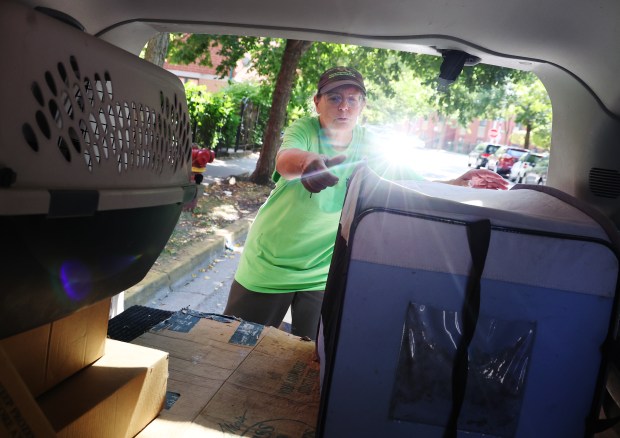
She recalled a rescue in early August that lasted seven hours. When Eyer got to Riis Park, she found a female Pekin duck commingling with a flock of mallards, and a bonded pair — a male Pekin and a female Swedish Blue, later named Whitey and Bluey — that were keeping to themselves. It took the combined efforts of her husband, a family passing by and a fisherman to finally corral the ducks just before sunset.
They were only able to capture the last one after catching its partner.
“The two of them had evaded us for hours at this point,” she said, “and within seconds of going into the crate, with all the noise the duck was making inside the crate, the other one just came walking out of the bushes and gave himself up. He was like, ‘OK, I surrender.’ It was happy and sad all at the same time.”
Prince’s recent rescue at Ping Tom Park took roughly half an hour — a quick turnaround for an often complicated operation.
She had invaluable help saving the ducks — later named Ping and Tom — from the volunteer on the water. A resident of the village of Wayne 40 miles west of Chicago, Jim Tibensky began kayak racing in 1967 and for 20 years has been volunteering for waterfowl rescues with the Chicago Bird Collision Monitors. Earlier that morning, Prince and Tibensky had rescued a Canada goose in Glenview whose leg had been injured with a fishing line.

After being radioed in, Tibensky chased the ducks to the riverbank opposite the park — wings furiously fluttering but never taking flight — and shepherded them one by one toward Prince.
“So you see that they can get away, but they can’t fly away, so it’s ultimately wearing them down,” she said as she put one of the ducks in a canvas carrier and picked off white feathers stuck to her hands.
Even if they can’t fly, waterfowl can swim and go underwater to escape predators and threats. But it’s not a sustainable survival strategy in Chicago when water freezes in the winter.
“When there’s partial ice, we never want them to dive under, because they then drown,” Prince said.
The bitter cold and icy ponds can not only be dangerous for the birds but also for rescuers, so volunteers try to save as many domestic ducks as possible before temperatures drop too much and bodies of water ice over.
“Our time is running out,” Prince said. “Their time is running out.”


